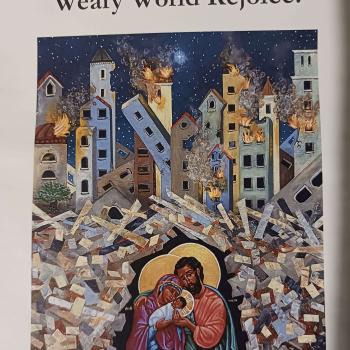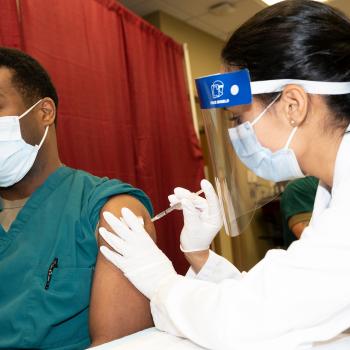Martin Luther had three problems with Catholic Eucharistic theology and practice. On two of them, withholding the cup from the laity and understanding the Mass as a sacrifice, he was vociferous. (I took on the sacrifice question in ecumenical dialogue here.) On the third, transubstantiation, he was much more sanguine. According to Luther, transubstantiation was one possible explanation of Eucharistic presence. But he did not himself find it to be the best one and he wished that it not be enforced as doctrine. Instead, he preferred that it be left as one philosophical option among many.
As far as we can tell, Luther never read Thomas on transubstantiation and it is not clear that he understood the doctrine all that clearly. This is actually good news from an ecumenical point of view. If what Luther found lacking in the doctrine was not actually lacking, there would be room for rapprochement.
One major problem that Luther had with transubstantiation is that it seemed to deny the reality of the bread and wine. Though Luther never used the term consubstantiation himself, many describe this as Luther’s position precisely because he insisted that the Body and Blood of Christ were present with (hence “con”) the bread and wine rather than replacing them.
 His argument for this was not merely empirical. He was not just pointing out the obvious fact of the physical bread and wine that remain after the consecration. No, his deeper point was that, because sacraments are rooted in the Incarnation, they must follow the logic of the Incarnation. And, since Christianity affirms that God was fully present in Jesus of Nazareth even while Jesus remained fully human, then God should be fully present in the bread and wine even as they remain fully bread and wine.
His argument for this was not merely empirical. He was not just pointing out the obvious fact of the physical bread and wine that remain after the consecration. No, his deeper point was that, because sacraments are rooted in the Incarnation, they must follow the logic of the Incarnation. And, since Christianity affirms that God was fully present in Jesus of Nazareth even while Jesus remained fully human, then God should be fully present in the bread and wine even as they remain fully bread and wine.
This, it seems to me, is a pretty good argument.
Those, like myself, wishing to defend transubstantiation need to take Luther’s point seriously. The good news is that if transubstantiation can answer this challenge, we should be one step closer to unity on that most important ecumenical issue, the sacrament of unity itself.
I want to start by noting that a Catholic denial of the reality of the bread and wine is a bit of an anomaly that arose in a polemical context. Catholics ended up denying the reality of bread and wine only because certain people (Berengar in the centuries before Thomas, Zwingli et. al. at the Reformation) were denying the reality of Christ’s Body and Blood. It was a classic case of people in an argument being forced into extremes by their opponents. When we read the Patristic sources, we find the Fathers quite blithely referring to the bread and wine and the Body and Blood with no sense of theological self-consciousness.
But, as I’ve noted before, a certain reality of the bread and wine must remain if the Eucharist is to be a sacrament because sacraments are places where God touches us via the earthbound and the material. In his excellent The Wedding Feast of the Lamb, Roch Kereszty, O. Cist puts it this way:
“the average post-Tridentine theologians began to emphasize that after the consecration the bread and wine remained bread and wine only in appearance. Thus, most Catholics in no way thought it permissible to speak about bread and wine after consecration: the species of bread and wine lost all measure of reality. It was not taken into account that the consecrated bread and wine do appear to the senses as bread and wine precisely to reveal to the eyes of faith that Christ’s sacrificed and risen humanity become true food and true drink for eternal life.”
Sometimes we pretend as if even the accidents (the physical reality of the bread and wine) aren’t really there. We talk as if they are a disguise. Thomas is unequivocal on this point: there is no deception in the sacrament! If you see (and touch and taste) the accidents of bread and wine it’s because they’re actually there.
And accidents aren’t nothing! When I teach a course on Eucharist, I have no trouble explaining to people what accidents are. Some of our contemporaries think that accidents are all that there are. Substance takes a lot more work to wrap one’s head around, but that’s another post.
In fact, our own liturgical language acknowledges the reality of the bread and wine in another way. After the consecration we often refer to the (capitalized) True Bread, or the Bread from Heaven. In a way, the bread is more bread than it has ever been before. The East even says that consecrated bread is bread that has finally become what bread was always meant to be, bread that has reached it telos, it’s proper end.
So, Catholics need not completely deny any reality to the bread and wine. The doctrine of transubstantiation itself insists that the physical reality remains as it was and that this reality is essential to the sacrament.
Nevertheless, Luther is right to point out that transubstantiation is not perfectly symmetrical with the theology of the Incarnation. While we insist very strongly that Jesus was both fully human and fully God, we deny that the consecrated species are fully bread and wine and also fully the Body and Blood of Christ. Aspects of the reality of bread and wine remain, but all that is fully present is Christ’s Body and Blood. According to Luther, this means that transubstantiation fails the test of Incarnational logic and is, as such, a poor option for understanding Eucharistic presence.
While this is certainly plausible, prima facie, I suggest that if we dig just a little deeper we will find that transubstantiation can, in fact, pass this test. And I certainly agree with Luther that it should.
What seems to me the key issue leading to the asymmetry between the Incarnation and Eucharistic Presence (and therefore any adequate philosophical articulation of it) is that bread is a very different kind of thing than a human person. There are many ways in which human persons and bread differ, at least a few of which could be explored in this context. (I hope, at some point, to reflect on the role of human freedom in this context, but I’ll need to go back and read my Sokolowski first.)
For now, however, I want to point out just one: the proper ends of human persons and bread are very different. The human person is created to be united with God. In that unity, Christians insist, our identity will not be lost like a drop in an infinite ocean, but found. In our union with God we become completely ourselves. That is why we can say that Jesus was more human than the rest of us.
Bread on the other hand is created to become a human body. Every one of us can, in all earnestness, take a piece of bread, announce that it is our body and eat it. It really does become our body. (What we can’t do, however, is take a piece of bread, announce that it is our body and then give it to others. Because the Eucharist is the means by which He makes the Church His Body, only Jesus can earnestly do that.)
And in the transformation into our bodies bread actually does lose its identity. It stops being bread and starts being body. We don’t look at someone on the street and think that here comes some strange combination of steak, potatoes, lettuce, corn, pickles, and mayonnaise. Food, once it has been eaten, stops being food. To lose its identity is its consummation.
But a human person never becomes anything other than a human person. Though their body be completely destroyed, they remain what they have been since God first knit body and soul together in a mother’s womb. The consummation of the human being is to be perfectly oneself, with God, forever.
This distinction between the final ends of bread and of human persons, it seems to me, is a good reason to think that transubstantiation does not transgress Incarnational logic. Furthermore, it shows that transubstantiation fulfills eschatological logic as well.
Brett Salkeld is a doctoral student in theology at Regis College in Toronto. He is a father of two (so far) and husband of one. He is writing his dissertation on the Eucharist and ecumenism.











